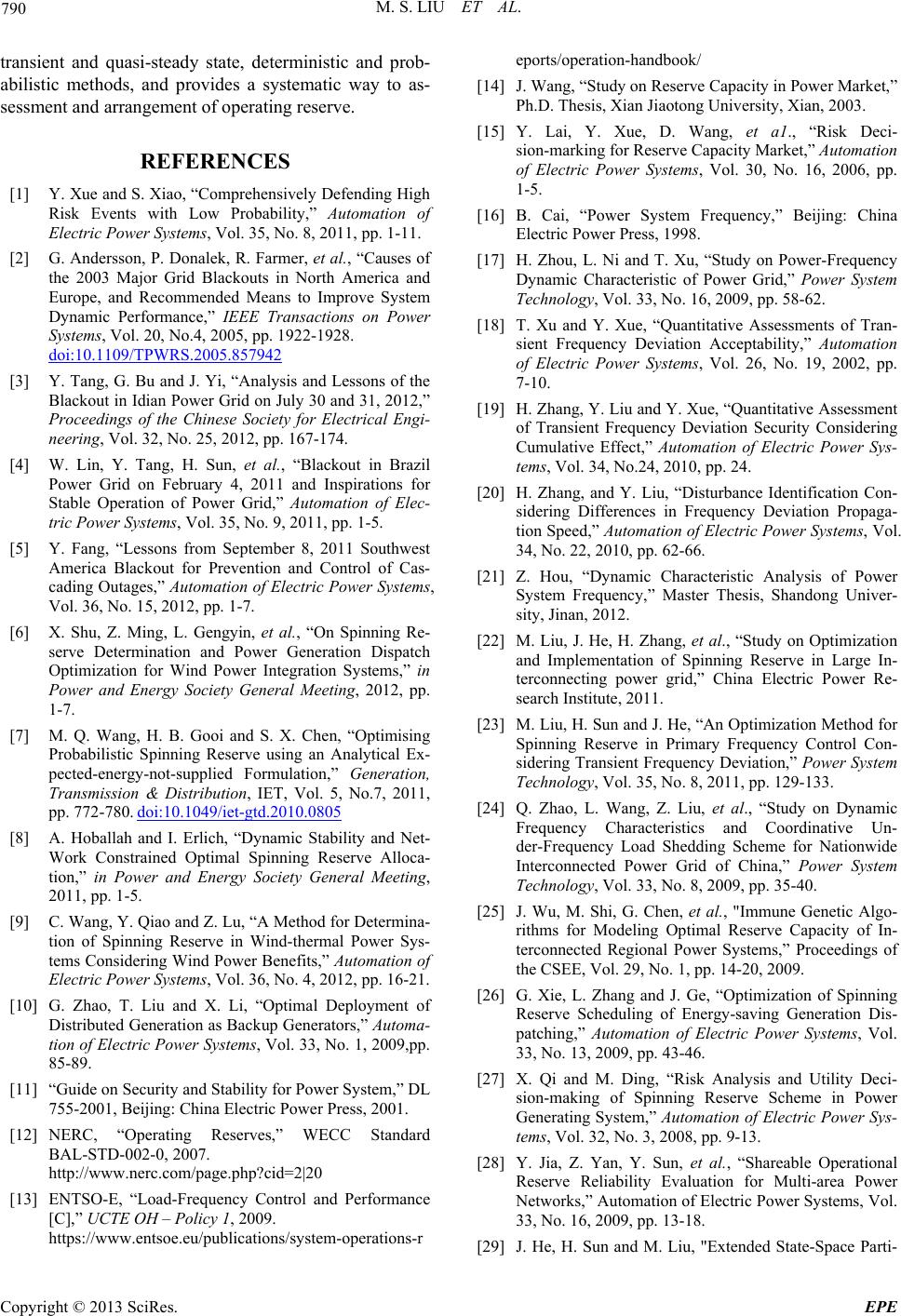
M. S. LIU ET AL.
790
transient and quasi-steady state, deterministic and prob-
abilistic methods, and provides a systematic way to as-
sessment and arrangement of operating reserve.
REFERENCES
[1] Y. Xue and S. Xiao, “Comprehensively Defending High
Risk Events with Low Probability,” Automation of
Electric Power Systems, Vol. 35, No. 8, 2011, pp. 1-11.
[2] G. Andersson, P. Donalek, R. Farmer, et al., “Causes of
the 2003 Major Grid Blackouts in North America and
Europe, and Recommended Means to Improve System
Dynamic Performance,” IEEE Transactions on Power
Systems, Vol. 20, No.4, 2005, pp. 1922-1928.
doi:10.1109/TPWRS.2005.857942
[3] Y. Tang, G. Bu and J. Yi, “Analysis and Lessons of the
Blackout in Idian Power Grid on July 30 and 31, 2012,”
Proceedings of the Chinese Society for Electrical Engi-
neering, Vol. 32, No. 25, 2012, pp. 167-174.
[4] W. Lin, Y. Tang, H. Sun, et al., “Blackout in Brazil
Power Grid on February 4, 2011 and Inspirations for
Stable Operation of Power Grid,” Automation of Elec-
tric Power Systems, Vol. 35, No. 9, 2011, pp. 1-5.
[5] Y. Fang, “Lessons from September 8, 2011 Southwest
America Blackout for Prevention and Control of Cas-
cading Outages,” Automation of Electric Power Systems,
Vol. 36, No. 15, 2012, pp. 1-7.
[6] X. Shu, Z. Ming, L. Gengyin, et al., “On Spinning Re-
serve Determination and Power Generation Dispatch
Optimization for Wind Power Integration Systems,” in
Power and Energy Society General Meeting, 2012, pp.
1-7.
[7] M. Q. Wang, H. B. Gooi and S. X. Chen, “Optimising
Probabilistic Spinning Reserve using an Analytical Ex-
pected-energy-not-supplied Formulation,” Generation,
Transmission & Distribution, IET, Vol. 5, No.7, 2011,
pp. 772-780. doi:10.1049/iet-gtd.2010.0805
[8] A. Hoballah and I. Erlich, “Dynamic Stability and Net-
Work Constrained Optimal Spinning Reserve Alloca-
tion,” in Power and Energy Society General Meeting,
2011, pp. 1-5.
[9] C. Wang, Y. Qiao and Z. Lu, “A Method for Determina-
tion of Spinning Reserve in Wind-thermal Power Sys-
tems Considering Wind Power Benefits,” Automation of
Electric Power Systems, Vol. 36, No. 4, 2012, pp. 16-21.
[10] G. Zhao, T. Liu and X. Li, “Optimal Deployment of
Distributed Generation as Backup Generators,” Automa-
tion of Electric Power Systems, Vol. 33, No. 1, 2009,pp.
85-89.
[11] “Guide on Security and Stability for Power System,” DL
755-2001, Beijing: China Electric Power Press, 2001.
[12] NERC, “Operating Reserves,” WECC Standard
BAL-STD-002-0, 2007.
http://www.nerc.com/page.php?cid=2|20
[13] ENTSO-E, “Load-Frequency Control and Performance
[C],” UCTE OH – Policy 1, 2009.
https://www.entsoe.eu/publications/system-operations-r
eports/operation-handbook/
[14] J. Wang, “Study on Reserve Capacity in Power Market,”
Ph.D. Thesis, Xian Jiaotong University, Xian, 2003.
[15] Y. Lai, Y. Xue, D. Wang, et a1., “Risk Deci-
sion-marking for Reserve Capacity Market,” Automation
of Electric Power Systems, Vol. 30, No. 16, 2006, pp.
1-5.
[16] B. Cai, “Power System Frequency,” Beijing: China
Electric Power Press, 1998.
[17] H. Zhou, L. Ni and T. Xu, “Study on Power-Frequency
Dynamic Characteristic of Power Grid,” Power System
Technology, Vol. 33, No. 16, 2009, pp. 58-62.
[18] T. Xu and Y. Xue, “Quantitative Assessments of Tran-
sient Frequency Deviation Acceptability,” Automation
of Electric Power Systems, Vol. 26, No. 19, 2002, pp.
7-10.
[19] H. Zhang, Y. Liu and Y. Xue, “Quantitative Assessment
of Transient Frequency Deviation Security Considering
Cumulative Effect,” Automation of Electric Power Sys-
tems, Vol. 34, No.24, 2010, pp. 24.
[20] H. Zhang, and Y. Liu, “Disturbance Identification Con-
sidering Differences in Frequency Deviation Propaga-
tion Speed,” Automation of Electric Power Systems, Vol.
34, No. 22, 2010, pp. 62-66.
[21] Z. Hou, “Dynamic Characteristic Analysis of Power
System Frequency,” Master Thesis, Shandong Univer-
sity, Jinan, 2012.
[22] M. Liu, J. He, H. Zhang, et al., “Study on Optimization
and Implementation of Spinning Reserve in Large In-
terconnecting power grid,” China Electric Power Re-
search Ins titute, 2011.
[23] M. Liu, H. Sun and J. He, “An Optimization Method for
Spinning Reserve in Primary Frequency Control Con-
sidering Transient Frequency Deviation,” Power System
Technology, Vol. 35, No. 8, 2011, pp. 129-133.
[24] Q. Zhao, L. Wang, Z. Liu, et al., “Study on Dynamic
Frequency Characteristics and Coordinative Un-
der-Frequency Load Shedding Scheme for Nationwide
Interconnected Power Grid of China,” Power System
Technology, Vol. 33, No. 8, 2009, pp. 35-40.
[25] J. Wu, M. Shi, G. Chen, et al., "Immune Genetic Algo-
rithms for Modeling Optimal Reserve Capacity of In-
terconnected Regional Power Systems,” Proceedings of
the CSEE, Vol. 29, No. 1, pp. 14-20, 2009.
[26] G. Xie, L. Zhang and J. Ge, “Optimization of Spinning
Reserve Scheduling of Energy-saving Generation Dis-
patching,” Automation of Electric Power Systems, Vol.
33, No. 13, 2009, pp. 43-46.
[27] X. Qi and M. Ding, “Risk Analysis and Utility Deci-
sion-making of Spinning Reserve Scheme in Power
Generating System,” Automation of Electric Power Sys-
tems, Vol. 32, No. 3, 2008, pp. 9-13.
[28] Y. Jia, Z. Yan, Y. Sun, et al., “Shareable Operational
Reserve Reliability Evaluation for Multi-area Power
Networks,” Automation of Electric Power Systems, Vol.
33, No. 16, 2009, pp. 13-18.
[29] J. He, H. Sun and M. Liu, "Extended State-Space Parti-
Copyright © 2013 SciRes. EPE